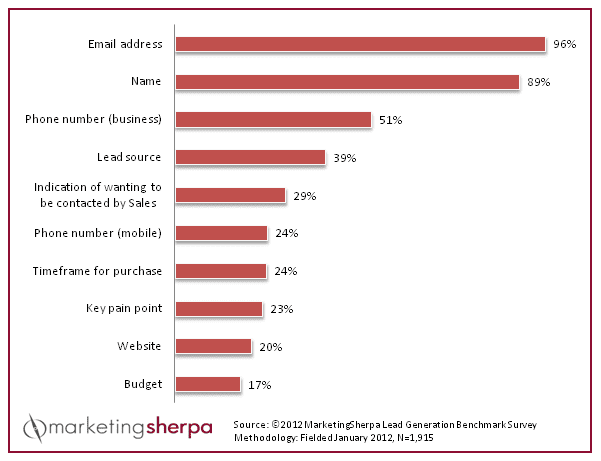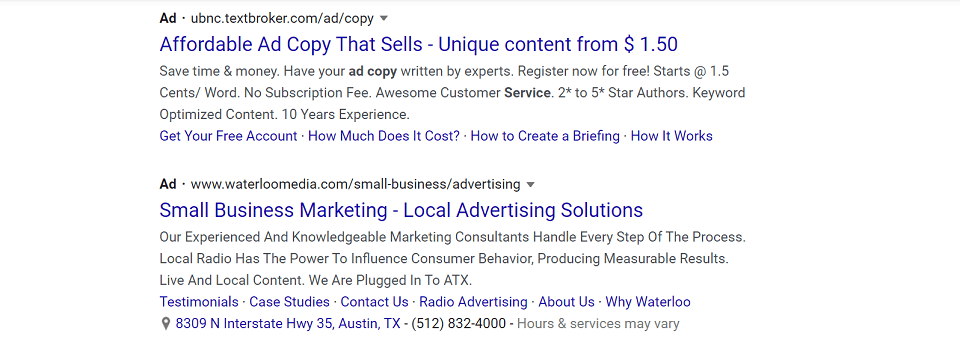Marketing Sherpa recently released another solid chart of the week, this one focused on form fields for lead generation. The chart summarizes the list of fields that marketers designated as the most important for lead generation forms.
And if you’re investing in digital advertising campaigns, you really need to get the forms right, lest you waste your money.
Before we get to the chart, let’s frame the topic to understand why this data is of great importance to demand generation professionals and email marketers.
Lead Quality Vs. Quantity
There has been a long-standing debate in the lead and demand generation field about the optimal number of fields to include in a lead conversion form.
It is true the the form needs to be built to match the call-to-action, the location, and the stage in the lead funnel where they are collected.
However, the adage still rings true that you should require fewer form fields to maximize conversion rates.
The answer is simple if you merely want to convert everyone possible, perhaps as a list-building effort for ongoing marketing automation / email marketing campaigns.
However, not all conversions are created equal.
When lead quality is more important, take a moment to re-evaluate whether or not to add additional form fields.
How does this factor into quality?
There are two ways:
- More data allows you to better filter and segment to focus sales efforts on the best potential fits for your product or service
- By making form submission a touch more cumbersome, you filter out all of the low quality tire kickers or people who are just looking to get a free download. Real prospects will be more likely to fill it all out.
Now that we’ve gotten part out of the way, let’s assume you want to maximize the volume of quality conversions.
That means we have to focus on the top handful of fields, and de-emphasize the rest of them.
Most Important Fields for Lead Generation Forms
Knowing we need to keep the list of fields to 3, 5, or 10 at most, let’s look at what data points marketers perceive as the highest values.

Most Important Fields: Analysis
Email Address
Email address, unsurprisingly, is the top dog.
Not only is it important for email or drip marketing, but it allows for a less intrusive first touch by a sales person if desired.
If you can only collect or “squeeze” one field out of prospects, this is the one.
Name
Name is logical, and it also serves a key purpose for personalization for any outreach post-conversion.
Some lead forms only ask for first name with this in mind, while others will ask for full name in one field, or both “First Name” and “Last Name” in two separate fields.
Business Phone Number
Again, this is a fine field to include if it is obvious that you are collecting leads with the intention of contacting them directly.
This field is unnecessary for straight list-building efforts.
Consider making this an optional field on initial submission. Then, then aim to populate it during your drip marketing follow up.
Lead Source
Every form should be tracking the most recent source for the visitor.
This does not have to be an overt question.
Many forms can track the page they came from and pass that along to the database via a hidden form field.
Don’t forget hidden fields, because they are great ways to get more data without compromising the user experience.
Willingness to be Contacted by Sales
Most lead generation efforts don’t even bother to ask this question.
If a form is asking for both email address and phone number, but not asking this one, you can be certain that they plan on following up by any means possible in short order.
Mobile Phone Number
I was surprised to see this field so high on the list.
If you choose to request mobile number, always make it optional. Most people don’t want to share their mobile number.
Personally, I walk away from any form that asks such intrusive questions and marks the fields as mandatory
Timeframe for Purchase
This is a great field to include if you are targeting hot leads with the form.
If you are merely list-building, I do not recommend using this field.
It presumes that the prospect is already pretty far down the sales funnel / buyer’s journey.
When they are at an advanced stage, it is perfectly acceptable.
However, it is inappropriate during early stages of the customer lifecycle. You know, those stages where they are just figuring out what your company does and whether they want to learn more.
Key Pain Point
Again, this presumes that the prospect has a pain point and an immediate need.
Great field for downfunnel leads, but avoid it for early stage list building.
Website
I always like to include this as an optional field when possible.
You can learn a lot from the company website, particularly if they are publicly traded.
Alternatively, you could sign up a data append service to add URL, SIC code, company size and revenue, location, and a variety of other information on the back end.
This is a good way to reduce field count, while still gathering enough data to profile the prospect before talking to them.
Budget
Budget is another field for downfunnel leads.
If they are at an advanced stage and have an established need, this is a sales qualification tool to determine whether the need is important enough for the company to fund it.
If so, you’ve got a hot lead, and someone needs to get them on the phone immediately.
Summary
The Sherpa chart only included the top 10 fields overall from their survey.
I’d be interested in seeing what the next 10 were.
Regardless, if you are aiming to maximize conversion rate and less worried about pre-qualification data, keep your form short and include the right fields for your marketing campaign.
This chart should help you select which ones to include.
Updated October 30, 2025
Tommy Landry
Latest posts by Tommy Landry (see all)
- B2B SEO in 2025: Winning Visibility in AI-Curated Buyer Journeys - December 16, 2025
- Local SEO Meets AEO and GEO: How AI Platforms Read Local Authority Signals - December 9, 2025
- What Is an SEO Proposal and What Should It Include? - December 2, 2025




